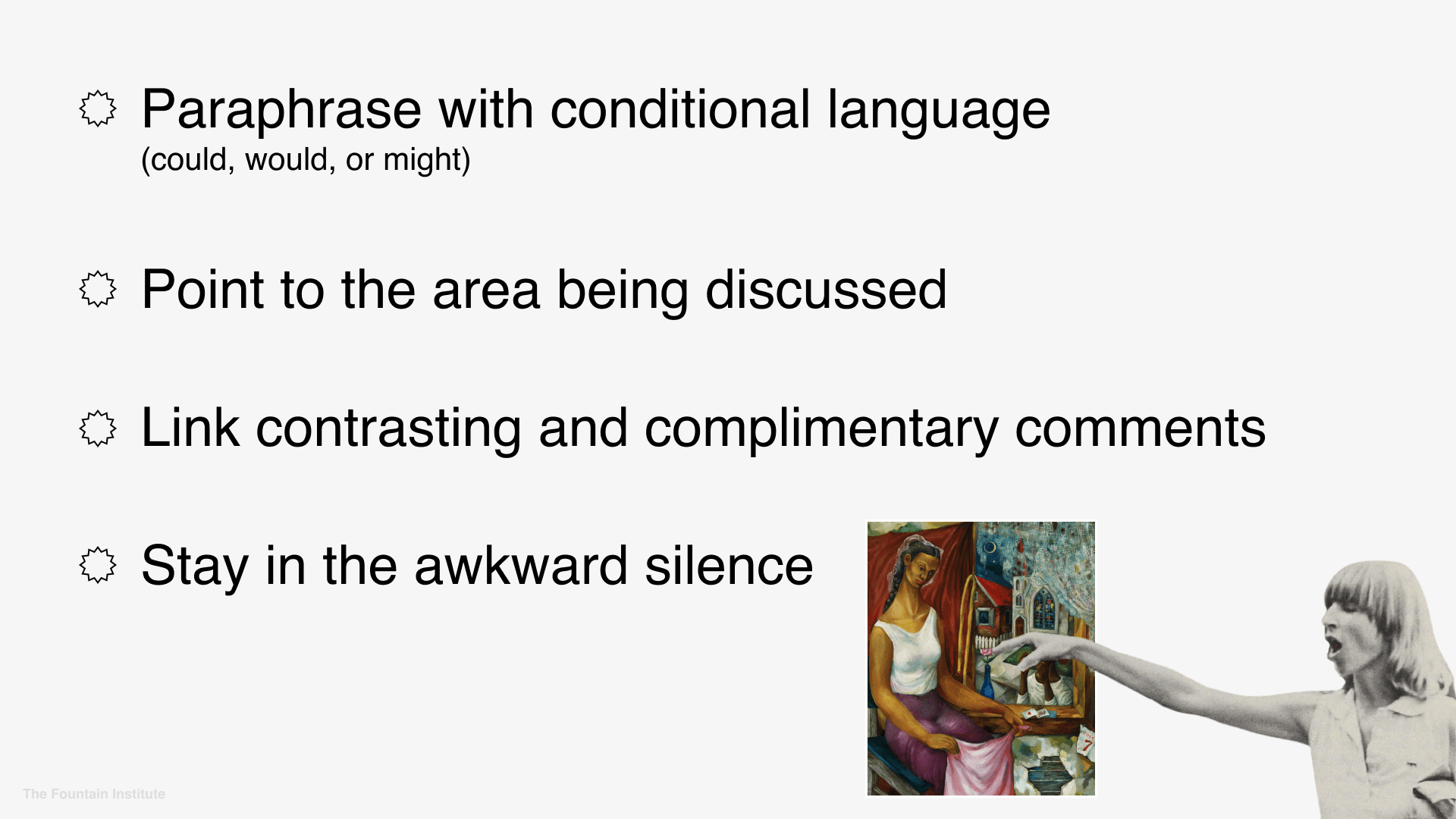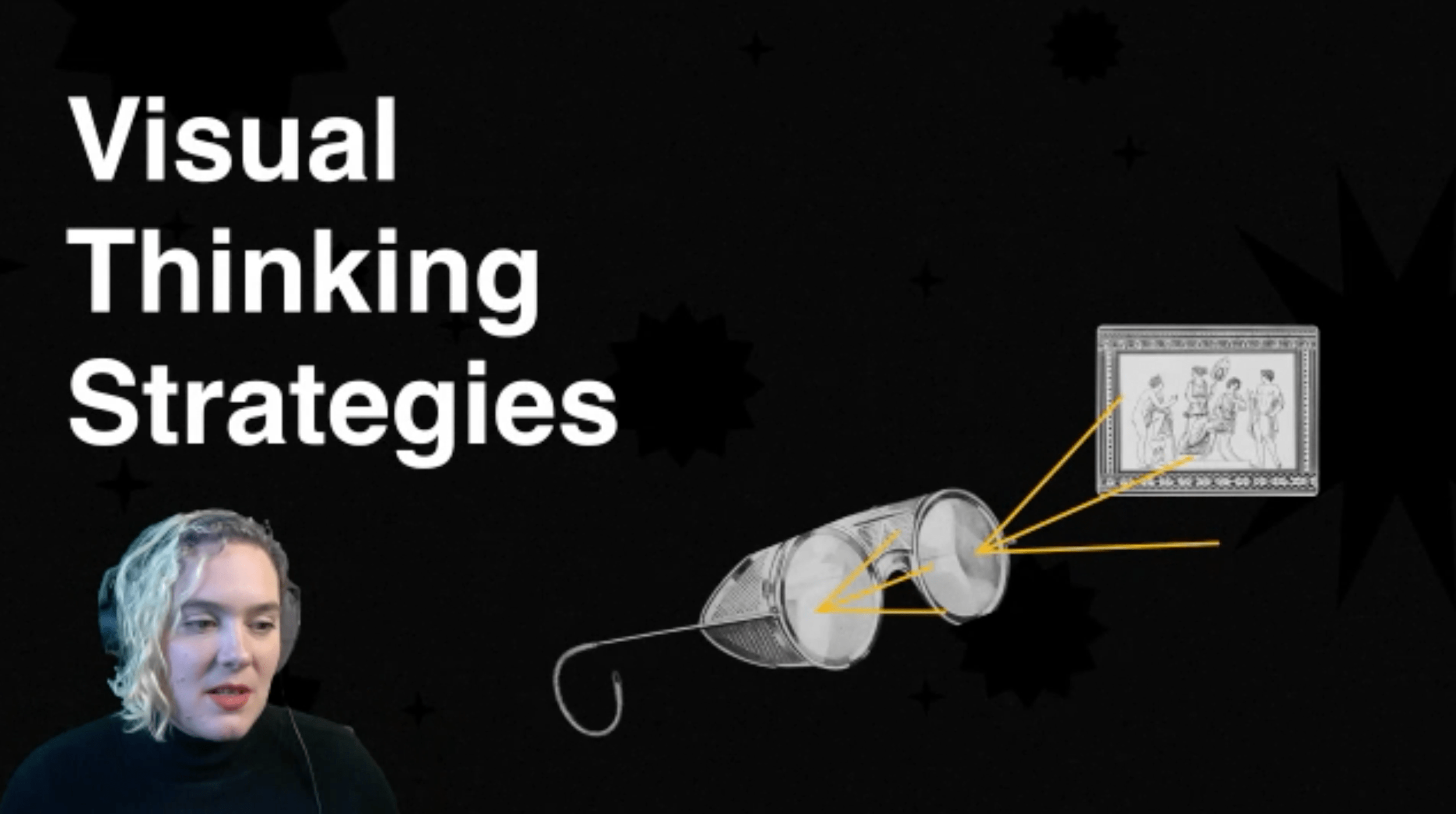Visual Thinking Strategies: Facilitate with Art
Learn how to guide the conversation around any visual with a facilitation method from art education.
Reading Time: 11 mins.
What if I told you that you could strengthen your innovation and facilitative leadership skills with a piece of art?
Allow me to introduce you to Visual Thinking Strategies (VTS). I discovered VTS almost 10 years ago when I used to work in museums and fell in love with the methodology.
What is Visual Thinking Strategies?
VTS is a facilitation and discussion methodology developed for art museums. VTS is done by a facilitator who leads a group discussion around a common focus (i.e., artwork, business artifact, object).
The facilitator begins the discussion by asking participants to silently look at the object for 60-seconds. Facilitators use carefully worded open-ended questions, active listening, paraphrasing, and link supporting/contrasting ideas to guide a group exploration of the common focus.
You guide the discussion by utilizing three carefully worded questions.
#1: “What’s going on in this image?"
The question, “What’s going on in this image?” opens up a conversation with the group about the artwork (could also be a research, object, wireframe, etc.).
It asks people to look closely and develop their own opinion on what is going on. It invites participants to form a view around the image without indicating there is a specific answer we are looking for.
There are many "right" answers and this type of question makes room for many diverse opinions.
As the facilitator, you begin to paraphrase participants' responses. You stay neutral and validate participants' ideas through paraphrasing without evaluating the responses.
Further into the discussion, the facilitator can link complementary and opposing remarks during the paraphrasing. Next is asking the participant to go deeper with the following question.
#2: “What do you see that makes you say that ___ ?”
After finishing the initial paraphrasing, the facilitator asks the same participant, "What do you see that makes you say that _____?” In the blank, you should mention something they said.
Question two asks the participant to supply evidence for their initial response, utilizing what they are "seeing" in the artwork. Participants are encouraged to use particular parts of the image to back up their first response. The second question encourages the participant to look deeper and articulate the thinking behind their thoughts.
The participants have to look again, reconstruct their thinking, and may develop a new hypothesis. Participants also learn to understand that there can be multiple perspectives of the given object.
I love question two because it really gets the audience to use their critical thinking skills.
#3: “What more can we find?”
Finally, we open the discussion back up to the group with "what more can we find?" Question three encourages the group to look for things we have not discovered and leaves room for other opinions.
The Visual Thinking Strategies Process:
Silent looking
Ask the 3 questions
Listen to understand
Paraphrase each comment
Remain neutral
Persist & explore
Benefits of VTS to Designers
Designers facilitate conversations around visuals every day. Whether it's a design critique or just an ad-hoc conversation about the user journey, VTS can move you from a participant in the conversation to an active leader.
VTS benefits in the design process:
Improves observation and communication skills during research
Helps navigate ambiguity in problems and solutions
Supports empathy for users AND stakeholders
Increases participation during workshops and ideation sessions
I would argue that facilitation skills are as essential to a designer as prototyping, visual design, and user research.
I believe in VTS so much that I made it a 2-year research project for my master’s thesis. What I didn’t realize at the time was that I was building facilitation and leadership skills that would support me indefinitely.
History of Visual Thinking Strategies
In the 1990s, Phillip Yenawine, MOMA director of education at the time, was asked by the board of trustees to investigate whether or not visitors were actually learning from the museum's programming.
Phillip asked Abigail Housen, a cognitive psychologist at Harvard, to help answer this question. Housen had been researching how people looked at art for 15 years and identified a developmental stage theory for aesthetics. Through this partnership, Visual thinking strategies was born.
VTS supports the growth of evidence-based reasoning and critical thinking skills. A study conducted in 1993 in Byron, Minnesota, explored the development of critical thinking skills and their transfer in VTS. Over the next 30 years, VTS was developed not only for museums but for school curricula from kindergarten to college levels.
Most recently, VTS has been adopted by the professional world. The Hailey Group uses VTS with business professionals, including innovation teams like IDEO.
They use VTS to develop a variety of skills in:
Observation skills
Active listening skills
Comfort with ambiguity
Critical thinking.
At the Fountain Institute, we use VTS as an education tool to train designers in slow looking, critique, and facilitation.
Being a participant in VTS can have many benefits to your team as mentioned above, but the main benefit of VTS for designers is to sharpen your facilitator's mindset.
The Facilitator’s Mindset
A facilitator's mindset is our perspective as facilitators. It’s what you are doing and thinking while you are in a facilitator role.
Visual Thinking Strategies is an excellent way to build the three aspects of the facilitator's mindset, building knowledge, staying neutral, and flexibility.
1.) Building Knowledge
The first thing you should remember is that facilitation is about building knowledge. You don't lecture or give everyone all the answers. It is about building it together. In VTS, it is a group effort to create knowledge around the image or object. As a great facilitator, you can walk up to any image, use VTS questions to engage in conversation with a group, and create a deeper understanding of the artwork without knowing any prior knowledge yourself.
2.) Being Neutral
The second aspect is staying neutral. Your opinions are not the most important in the room. Your responsibility is to harvest an environment where the other participants feel comfortable expressing their ideas. Being neutral as a facilitator can be challenging but remember to use conditional language (should, would might), link contrasting and similar ideas, and avoid leading questions.
3.) Staying Flexible
The last aspect of the facilitator's mindset is flexibility. Things will not go as you planned. That doesn't mean you shouldn't plan but be comfortable knowing that things will change and allowing yourself to not be overwhelmed by this change. VTS teaches you this as you jump into every conversation without knowing where the discussion will lead you. You have a loose structure with the three questions, but you do not know what your participants will say. You can not prepare the paraphrasing beforehand.
Visual Thinking Strategies Example
VTS can sometimes be hard to explain so why don’t I just show you? This video is an example of how you can use VTS as a training method for facilitators.
In the demo video, I use VTS to facilitate the conversation around a piece of art and demonstrate the power of facilitation methods like VTS:
It’s hard to learn facilitation skills, and VTS is a proven methodology to do that.
Leading doesn't mean you have to have all the answers. Sometimes, it's about asking the right questions.
Audience Strategy Worksheet
Put your audience before anything else with this FREE worksheet.





